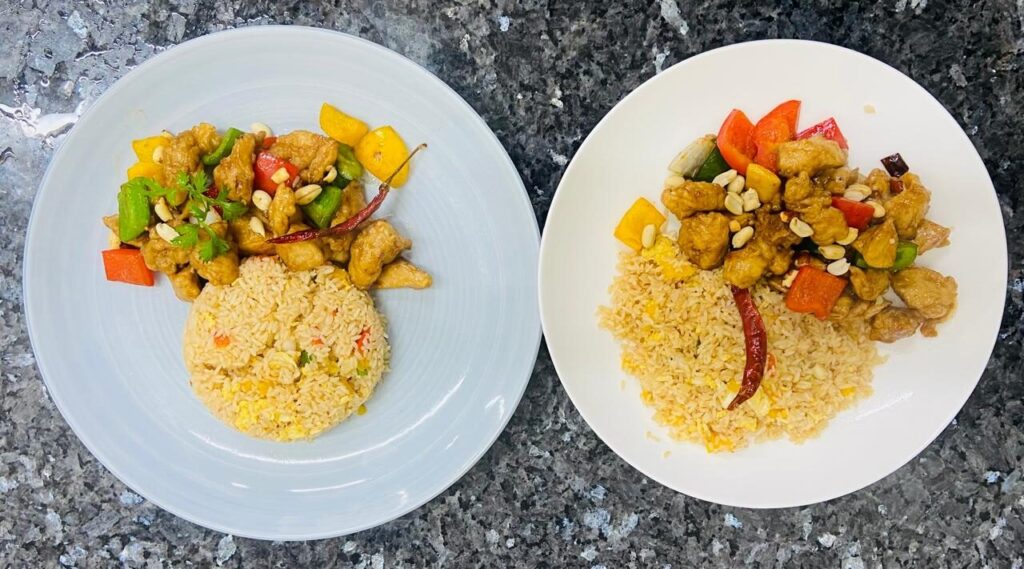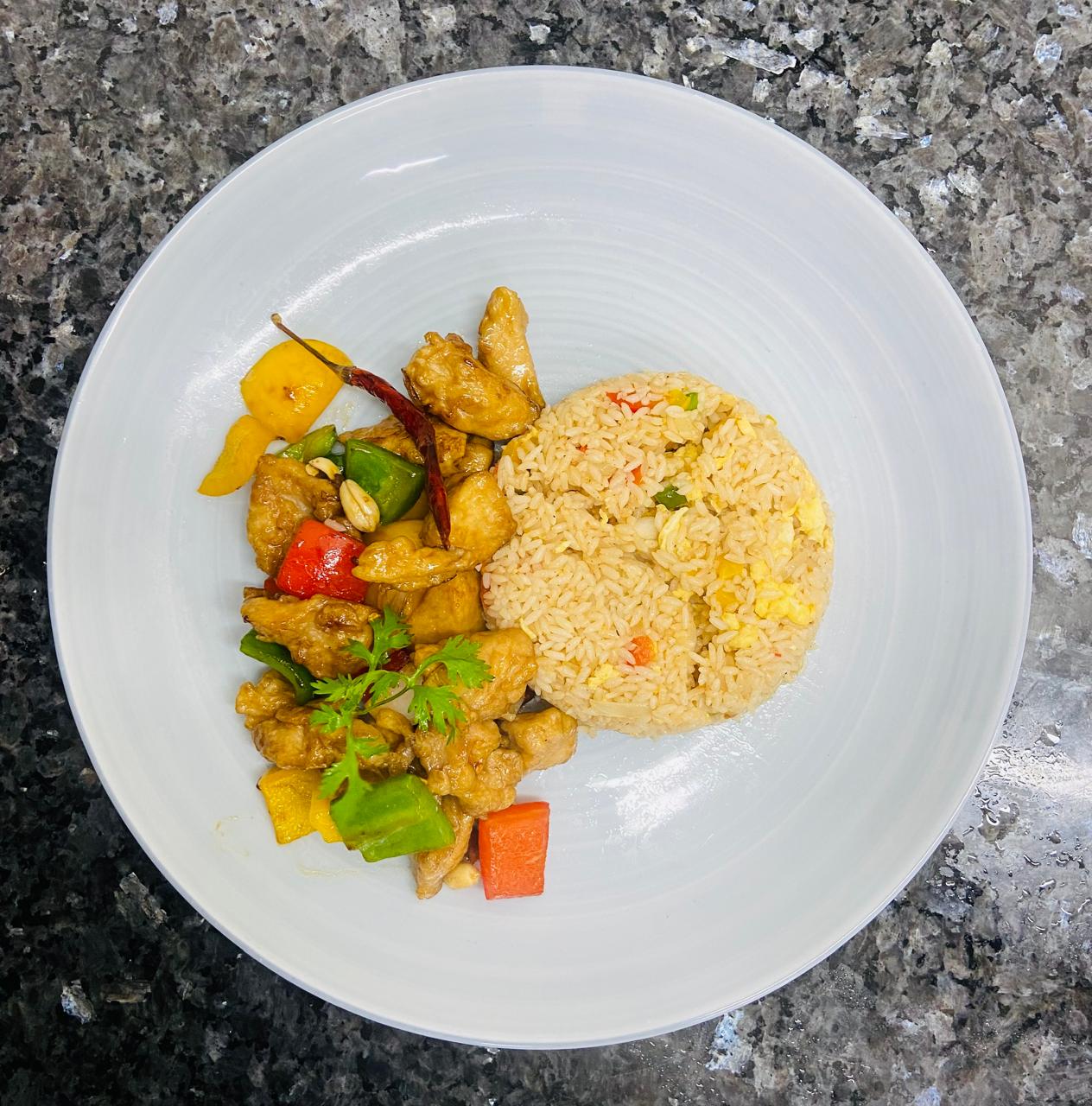Kung Pao Chicken

Kung Pao Chicken is a classic dish that marries tender chicken cubes with a mix of vibrant vegetables, nuts, and a perfectly balanced sauce. Originally from the Sichuan province in China, Kung Pao Chicken has gained global popularity for its simple yet satisfying taste, blending savory, sweet, and tangy flavors. In this version, we’ll stick to the essence of the dish while ensuring it retains its colorful presentation, crunch, and bold flavors.
Ingredients (Serves 4)
For this recipe, we’ll balance protein, vegetables, and healthy fats with some added garnish for an extra crunch. Here’s what you’ll need:
– Chicken: 300 grams of chicken breast, cubed into bite-sized pieces. The lean protein helps build a hearty, filling base for the dish.
– Capsicum (Bell Peppers): 1/2 cup each of red, green, and yellow capsicum. These provide vibrant color and a sweet yet slightly tangy flavor, perfectly complementing the savory chicken.
– Roasted Peanuts or Cashew Nuts: 1/4 cup, lightly roasted. These nuts bring a toasty flavor and a crunchy contrast to the tender chicken and soft veggies. Feel free to use either peanuts or cashew nuts based on your preference.

For the Sauce:
– Soy Sauce: 3 tablespoons soy sauce for saltiness and umami flavor.
– Oyster Sauce: 2 tablespoons to deepen the richness of the dish.
– Rice Vinegar: 1 tablespoon rice vinegar to add a sharp tang and balance the sweet and savory notes.
– Tomato Sauce (Ketchup): 1 tablespoon to introduce a mild sweetness and smooth texture.
– Tomato Paste: 1 tablespoon for a more concentrated tomato flavor that thickens the sauce.
– Salt and Pepper: To taste. Remember, soy sauce already has salt, so adjust accordingly.
Step-by-Step Process:
1. Preparing the Chicken and Vegetables:
Start by cutting the chicken breast into small cubes, roughly 1-inch pieces. This ensures the chicken cooks evenly and remains tender. Set it aside and chop the capsicum into similarly sized pieces. The capsicum will provide a bright contrast both visually and in texture to the chicken.
Pro Tip: When cutting the capsicum, try to maintain uniformity in size to ensure that they cook evenly. The three different colors of the capsicum—red, yellow, and green—add vibrancy, flavor, and nutrition to the dish.
2. Preparing the Sauce:
In a small bowl, whisk together the soy sauce, oyster sauce, rice vinegar, tomato sauce, and tomato paste. This combination of ingredients creates the signature sweet, savory, and tangy flavor profile Kung Pao Chicken is known for.
The soy sauce serves as the base, offering a deep umami flavor, while the oyster sauce brings a touch of richness. The rice vinegar cuts through the richness with its tangy, acidic bite, and the tomato components add both sweetness and a thicker consistency to the sauce.
Note: Adjust the balance of sweetness and saltiness based on your preference, but remember that too much sauce can make the dish overly salty or tangy.
3. Cooking the Chicken:
In a large pan or wok, heat 2 tablespoons of oil over medium heat. Add the cubed chicken and stir-fry for about 5-7 minutes until fully cooked. The goal is to achieve a slight golden color on the outside of the chicken while keeping the inside moist and tender.
Once the chicken is done, you can remove it from the pan and set it aside.
4. Stir-Frying the Vegetables:
Using the same pan, add another tablespoon of oil if needed. Toss in the chopped capsicum and stir-fry for 3-4 minutes. You want the vegetables to be slightly tender but still maintain their crunch. This is essential to the textural balance of the dish.
Tip: Stir-frying over medium-high heat ensures the vegetables don’t become soggy and retain their vibrant colors and textures.
5. Combining Chicken and Vegetables:
Once the capsicum has softened a little, add the cooked chicken back into the pan. Pour the sauce over the chicken and vegetables, and stir everything together so it’s well coated. Let it cook for 2-3 minutes until the sauce thickens and sticks to the chicken and veggies.
If you find the sauce too thick, add a splash of water to adjust the consistency.
6. Garnishing with Roasted Nuts:
Finally, for the finishing touch, sprinkle the roasted peanuts or cashew nuts over the chicken just before serving. These roasted nuts provide a lovely crunch that complements the tender chicken and sautéed vegetables.
Serving Suggestions:
Serve Kung Pao Chicken hot, preferably with steamed jasmine rice or a bowl of stir-fried noodles on the side. The rice or noodles will help balance the bold flavors of the sauce, making for a satisfying meal.
Kung Pao Chicken pairs wonderfully with several side dishes. Here are a few popular options:
1. Steamed Jasmine Rice:
The soft and mildly fragrant jasmine rice absorbs the rich Kung Pao sauce, balancing out the flavors and providing a neutral base for the bold chicken stir-fry.
2. Fried Rice:
A flavorful alternative, fried rice with vegetables or egg complements the savory and slightly spicy notes of the Kung Pao Chicken. Check our easy egg-fried recipe.
3. Stir-Fried Noodles:
Noodles, such as lo mein or chow mein, can make the meal more filling and add another layer of texture to the dish.
4. Quinoa or Brown Rice:
For a healthier option, you can serve Kung Pao Chicken with quinoa or brown rice, which provides more fiber and nutrients.
Any of these dishes will make a satisfying and balanced meal alongside Kung Pao Chicken.
For an extra kick, you can sprinkle some chopped spring onions or chili flakes on top, but this is optional depending on your spice preference.
check more chicken recipes here
Nutritional Information (Per Serving)
– Calories: 320 kcal
– Protein: 24g
– Carbohydrates: 18g
– Fat: 17g
– Fiber: 4g
– Sugars: 6g
– Sodium: 900mg (due to soy sauce, adjust as needed)
Important Notes:
1. Use of Nuts: Peanuts or cashew nuts are crucial to the dish, adding a crunchy texture that contrasts with the tender meat and veggies. Roasting the nuts beforehand enhances their flavor and makes them more aromatic. If you’re serving someone with a nut allergy, these can be left out or replaced with seeds like pumpkin seeds.
2. Capsicum Selection: The trio of red, yellow, and green capsicum is important not just for flavor but for visual appeal. Each color offers a slightly different taste—red is sweet, green is more peppery, and yellow is mild—providing a balanced flavor palette.
3. Seasoning: Because both soy sauce and oyster sauce are inherently salty, be cautious with additional salt. Taste the dish before adding any extra seasoning.
4. Vegan Version: For a vegetarian or vegan twist, you could replace chicken with tofu or plant-based protein while keeping the rest of the ingredients the same.
Kung Pao Chicken, with its savory sauce, crunchy nuts, and colorful vegetables, is a perfect stir-fry for family meals or dinner gatherings. This recipe keeps the essence of the original dish while incorporating accessible ingredients to suit every palate.




[…] check more chicken recipes here […]